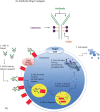Linked-in: design and efficacy of antibody drug conjugates in oncology
- PMID: 23651630
- PMCID: PMC3717303
- DOI: 10.18632/oncotarget.924
Linked-in: design and efficacy of antibody drug conjugates in oncology
Abstract
The use of antibody drug conjugates (ADCs) as targeted chemotherapies has successfully entered clinical practice and holds great promise. ADCs consist of an antibody and toxin-drug combined together via a chemical linker. While the antibody and drug are of vital importance in the direct elimination of cancer cells, more advanced linker technology was instrumental in the delivery of more potent drugs with fewer side effects. Here, we discuss the preclinical experience as well as clinical trials, with a specific emphasis on the clinical outcomes and side effects, in addition to linker strategies for five different ADCs, in order to describe different approaches in the development of this new class of anticancer agents. Brentuximab vedotin is approved for use in Hodgkin's lymphoma and Trastuzumab emtansine is approved for breast cancer. Combotox, Inotuzumab Ozogamicin, and Moxetumomab Pasudotox are in various stages of clinical development and are showing significant efficacy in lymphoid malignancies. These ADCs illustrate the promise and future potential of targeted therapy for presently incurable malignancies.
Figures


Similar articles
-
Antibody-drug conjugates in clinical trials for lymphoid malignancies and multiple myeloma.J Hematol Oncol. 2019 Sep 10;12(1):94. doi: 10.1186/s13045-019-0786-6. J Hematol Oncol. 2019. PMID: 31500657 Free PMC article. Review.
-
Current Phase II antibody-drug conjugates for the treatment of lymphoid malignancies.Expert Opin Investig Drugs. 2014 Jul;23(7):911-24. doi: 10.1517/13543784.2014.908184. Epub 2014 Apr 7. Expert Opin Investig Drugs. 2014. PMID: 24708159 Review.
-
Developments in the use of antibody-drug conjugates.Am Soc Clin Oncol Educ Book. 2013. doi: 10.14694/EdBook_AM.2013.33.e99. Am Soc Clin Oncol Educ Book. 2013. PMID: 23714468 Review.
-
The next generation of antibody drug conjugates.Semin Oncol. 2014 Oct;41(5):637-52. doi: 10.1053/j.seminoncol.2014.08.001. Epub 2014 Aug 12. Semin Oncol. 2014. PMID: 25440608 Review.
-
World Antibody Drug Conjugate Summit Europe: February 21-23, 2011; Frankfurt, Germany.MAbs. 2011 Jul-Aug;3(4):331-7. doi: 10.4161/mabs.3.4.16612. Epub 2011 Jul 1. MAbs. 2011. PMID: 21691144 Free PMC article.
Cited by
-
Aptamer-Drug Conjugates of Active Metabolites of Nucleoside Analogs and Cytotoxic Agents Inhibit Pancreatic Tumor Cell Growth.Mol Ther Nucleic Acids. 2017 Mar 17;6:80-88. doi: 10.1016/j.omtn.2016.11.008. Epub 2016 Dec 10. Mol Ther Nucleic Acids. 2017. PMID: 28325302 Free PMC article.
-
Antibody-Drug Conjugates for the Treatment of Hematological Malignancies: A Comprehensive Review.Target Oncol. 2018 Jun;13(3):287-308. doi: 10.1007/s11523-018-0558-1. Target Oncol. 2018. PMID: 29556925 Review.
-
Evaluation of SAS1B as a target for antibody-drug conjugate therapy in the treatment of pancreatic cancer.Oncotarget. 2018 Jan 4;9(10):8972-8984. doi: 10.18632/oncotarget.23944. eCollection 2018 Feb 6. Oncotarget. 2018. PMID: 29507667 Free PMC article.
-
Novel drug targets for personalized precision medicine in relapsed/refractory diffuse large B-cell lymphoma: a comprehensive review.Mol Cancer. 2015 Dec 11;14:207. doi: 10.1186/s12943-015-0474-2. Mol Cancer. 2015. PMID: 26654227 Free PMC article. Review.
-
Front-End Electron Transfer Dissociation Coupled to a 21 Tesla FT-ICR Mass Spectrometer for Intact Protein Sequence Analysis.J Am Soc Mass Spectrom. 2017 Sep;28(9):1787-1795. doi: 10.1007/s13361-017-1702-3. Epub 2017 Jul 18. J Am Soc Mass Spectrom. 2017. PMID: 28721671 Free PMC article.
References
-
- Strebhardt K, Ullrich A. Paul Ehrlich's magic bullet concept: 100 years of progress. Nat Rev Cancer. 2008;8(6):473–480. - PubMed
-
- Mathe G, LO TB, Bernard J. Effect on mouse leukemia 1210 of a combination by diazo-reaction of amethopterin and gamma-globulins from hamsters inoculated with leukemia by heterografts. C R Hebd Seances Acad Sci. 1958;246(10):1626–1628. - PubMed
-
- Piascik PP. FDA approves fusion protein for treatment of lymphoma. J Am Pharm Assoc (Wash) 1999;39(4):571–572. - PubMed
-
- Leget GA, Czuczman MS. Use of rituximab, the new FDA-approved antibody. Current Opinion in Oncology. 1998;10(6):548–551. - PubMed
-
- Hussain N. Ligand-mediated tissue specific drug delivery. Advanced Drug Delivery Reviews. 2000;43(2–3):95–100. - PubMed
MeSH terms
Substances
LinkOut - more resources
Full Text Sources
Other Literature Sources

